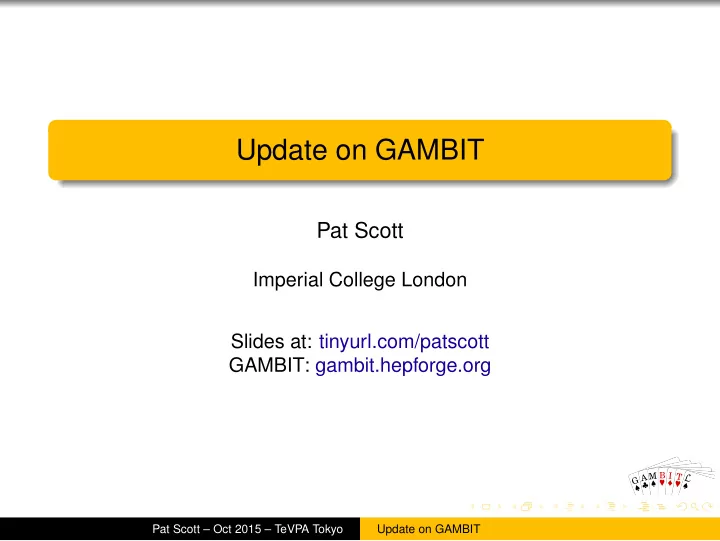

Update on GAMBIT Pat Scott Imperial College London Slides at: tinyurl.com/patscott GAMBIT: gambit.hepforge.org M B I A T G Pat Scott – Oct 2015 – TeVPA Tokyo Update on GAMBIT
Global fits for dark matter and new physics Current global fit codes are hardcoded to deal with only a few theories (MSSM and/or mSUGRA+friends) theory calculators (often interfaced in a very ad hoc way) datasets and observables (often missing detailed likelihoods) scanning algorithms and statistical methods (generally just one) = ⇒ hitting the wall on theories, data & computational methods M B I A T G Pat Scott – Oct 2015 – TeVPA Tokyo Update on GAMBIT
Global fits for dark matter and new physics Current global fit codes are hardcoded to deal with only a few theories (MSSM and/or mSUGRA+friends) theory calculators (often interfaced in a very ad hoc way) datasets and observables (often missing detailed likelihoods) scanning algorithms and statistical methods (generally just one) = ⇒ hitting the wall on theories, data & computational methods How to quickly recast data, likelihood functions, scanning code ‘housekeeping’ and even theory predictions to new theories? ⇒ a new, very general global fitting framework = M B I A T G Pat Scott – Oct 2015 – TeVPA Tokyo Update on GAMBIT
Global fits for dark matter and new physics Current global fit codes are hardcoded to deal with only a few theories (MSSM and/or mSUGRA+friends) theory calculators (often interfaced in a very ad hoc way) datasets and observables (often missing detailed likelihoods) scanning algorithms and statistical methods (generally just one) = ⇒ hitting the wall on theories, data & computational methods How to quickly recast data, likelihood functions, scanning code ‘housekeeping’ and even theory predictions to new theories? ⇒ a new, very general global fitting framework = ⇒ GAMBIT = M B I A T G Pat Scott – Oct 2015 – TeVPA Tokyo Update on GAMBIT
GAMBIT : a second-generation global fit code GAMBIT: The Global And Modular BSM Inference Tool Overriding principles of GAMBIT: flexibility and modularity General enough to allow fast definition of new datasets and theoretical models Plug and play scanning, physics and likelihood packages Extensive model database – not just small modifications to constrained MSSM (NUHM, etc), and not just SUSY! Extensive observable/data libraries (likelihood modules) Many statistical options – Bayesian/frequentist, likelihood definitions, scanning algorithms A smart and fast LHC likelihood calculator Massively parallel Full open-source code release M B I A T G Pat Scott – Oct 2015 – TeVPA Tokyo Update on GAMBIT
The GAMBIT Collaboration 30 Members, 16 institutions, 10 countries, M B I T A G 11 Experiments, 4 major theory codes Fermi-LAT J. Conrad, J. Edsjö, G. Martinez P . Scott ATLAS A. Buckley, P . Jackson, C. Rogan, M. White, CTA C. Balázs, T. Bringmann, J. Conrad, M. White HESS J. Conrad LHCb M. Chrza ¸szcz, N. Serra IceCube J. Edsjö, P . Scott AMS-02 A. Putze CDMS, DM-ICE L. Hsu XENON/DARWIN J. Conrad Theory P . Athron, C. Balázs, T. Bringmann, J. Cornell, L. Dal, J. Edsjö, B. Farmer, A. Krislock, A. Kvellestad, M. Pato, F . Mahmoudi, A. Raklev, P . Scott, C. Weniger, M. White Also recently joined or left: T. Gonzales, J. McKay, R. Ruiz, M B I A T G A. Saavedra, C. Savage, R. Trotta Pat Scott – Oct 2015 – TeVPA Tokyo Update on GAMBIT
Modules Physics modules DarkBit – dark matter observables (relic density, direct + indirect detection) ColliderBit – collider observables inc. Higgs + SUSY searches from ATLAS, CMS + LEP FlavBit – flavour physics inc. g − 2, b → s γ , B decays (new channels, angular obs., theory uncerts, LHCb likelihoods) SpecBit – generic BSM spectrum object, providing RGE running, masses, mixings, etc via interchangeable interfaces to different RGE codes DecayBit – decay widths for all relevant SM & BSM particles PrecisionBit – SM likelihoods, precision BSM tests ( W mass, ∆ ρ etc) Each consists of a number of module functions that can have dependencies on each other M B I A T G +ScannerBit: manages stats, sampling and optimisation Pat Scott – Oct 2015 – TeVPA Tokyo Update on GAMBIT
Hierarchical Model Database Models are defined by their parameters and relations to each other Models can inherit from parent models Points in child models can be automatically translated to ancestor models Friend models also allowed (cross-family translation) Model dependence of every function/observable is tracked ⇒ maximum safety, maximum reuse = StandardModel_SLHA2 StandardModel_HiggsSector StandardModel_Higgs nuclear_params_fnq nuclear_params_sigma0_sigmal nuclear_params_sigmas_sigmal LocalHalo NUHM2 NUHM1 CMSSM VCMSSM mSUGRAb NormalDist mSUGRA SingletDM MSSM78atMGUT MSSM30atMGUT MSSM15atQ MSSM10catQ MSSM78atQ MSSM30atQ MSSM25atQ MSSM24atQ MSSM10atQ MSSM20atQ MSSM19atQ MSSM16atQ MSSM11atQ MSSM10batQ M B I A T MSSM9atQ G MSSM7atQ Pat Scott – Oct 2015 – TeVPA Tokyo Update on GAMBIT
Backends: mix and match Module functions can require specific functions from backends Backends are external code libraries (DarkSUSY, FeynHiggs, etc) that include different functions GAMBIT automates and abstracts the interfaces to backends → backend functions are tagged according to what they calculate → with appropriate module design, different backends and their functions can be used interchangeably GAMBIT dynamically adapts to use whichever backends are actually present on a user’s system (+ provides details of what it decided to do of course) M B I A T G Pat Scott – Oct 2015 – TeVPA Tokyo Update on GAMBIT
Backends: mix and match M B I A T G Pat Scott – Oct 2015 – TeVPA Tokyo Update on GAMBIT
Backends: mix and match M B I A T G Pat Scott – Oct 2015 – TeVPA Tokyo Update on GAMBIT
Recommend
More recommend